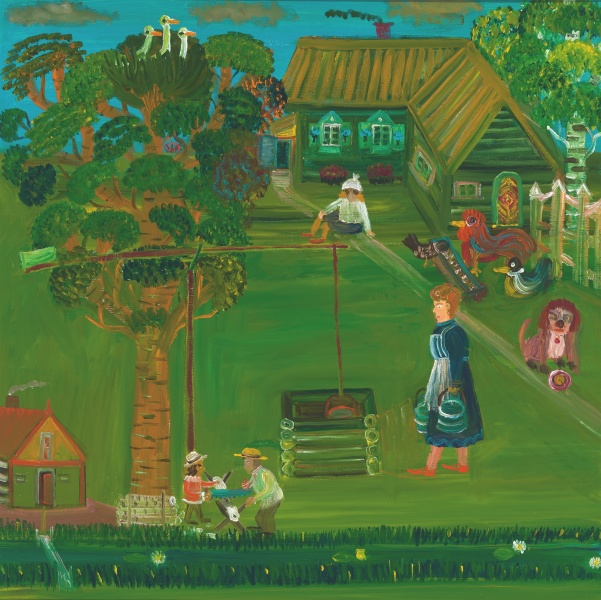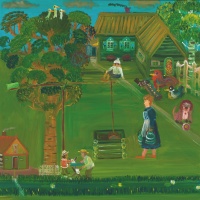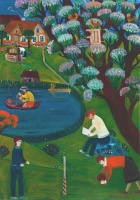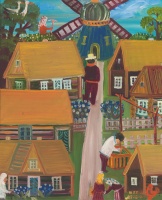

Chopping firewood
| Author: | Monika Bičiūnienė (1910–2009) |
Monika Bičiūnienė is an outstanding representative of Naïve Art. She was born in the village of Baubliai in the Rokiškis district in on 28 April 1910, the daughter of a fisherman and a weaver. She began to draw and paint when her son entered the M.K. Čiurlionis School of Arts. After retiring and settling in Vilnius in 1969, she painted a happy and poetic world from memory. Her view was that earthly paradise was eternal, stable and never ending. It was only human life that was brittle, and therefore every moment was precious. Bičiūnienė tried to eternalise these moments, and painted country festivals, cottages, nature, blossoming trees and flowers in gardens, domestic animals and birds, and, of course, the people around her.
Bičiūnienė lived a long and happy life. She held nearly 30 personal exhibitions, not only in Lithuania but abroad as well, in India and Finland. Her works have been shown and appreciated in exhibitions of Lithuanian folk art in other countries (England, Belgium, Bulgaria, Estonia, Latvia, France and Russia). The artist was awarded the Paulius Galaunė Prize. She left a huge legacy of paintings. Some of her works were reproduced in the World Encyclopedia of Naive Art published in Belgrade in 1984.
In her work, Bičiūnienė remained faithful to her native district of Rokiškis, its nature, stories, tales, songs, views and customs. Even today, we can use her pictures to study the culture of a north Lithuanian ethnographic village.
Source: Valiunas Ellex (LAWIN until 2015) art album: THE WORLD OF LANDSCAPES II (2013). Compiler and author Nijolė Tumėnienė.

Monika Bičiūnienė is an outstanding representative of Naïve Art. She was born in the village of Baubliai in the Rokiškis district in on 28 April 1910, the daughter of a fisherman and a weaver. She began to draw and paint when her son entered the M.K. Čiurlionis School of Arts. After retiring and settling in Vilnius in 1969, she painted a happy and poetic world from memory. Her view was that earthly paradise was eternal, stable and never ending. It was only human life that was brittle, and therefore every moment was precious. Bičiūnienė tried to eternalise these moments, and painted country festivals, cottages, nature, blossoming trees and flowers in gardens, domestic animals and birds, and, of course, the people around her.
Bičiūnienė lived a long and happy life. She held nearly 30 personal exhibitions, not only in Lithuania but abroad as well, in India and Finland. Her works have been shown and appreciated in exhibitions of Lithuanian folk art in other countries (England, Belgium, Bulgaria, Estonia, Latvia, France and Russia). The artist was awarded the Paulius Galaunė Prize. She left a huge legacy of paintings. Some of her works were reproduced in the World Encyclopedia of Naive Art published in Belgrade in 1984.
In her work, Bičiūnienė remained faithful to her native district of Rokiškis, its nature, stories, tales, songs, views and customs. Even today, we can use her pictures to study the culture of a north Lithuanian ethnographic village.
Source: Valiunas Ellex (LAWIN until 2015) art album: THE WORLD OF LANDSCAPES II (2013). Compiler and author Nijolė Tumėnienė.








